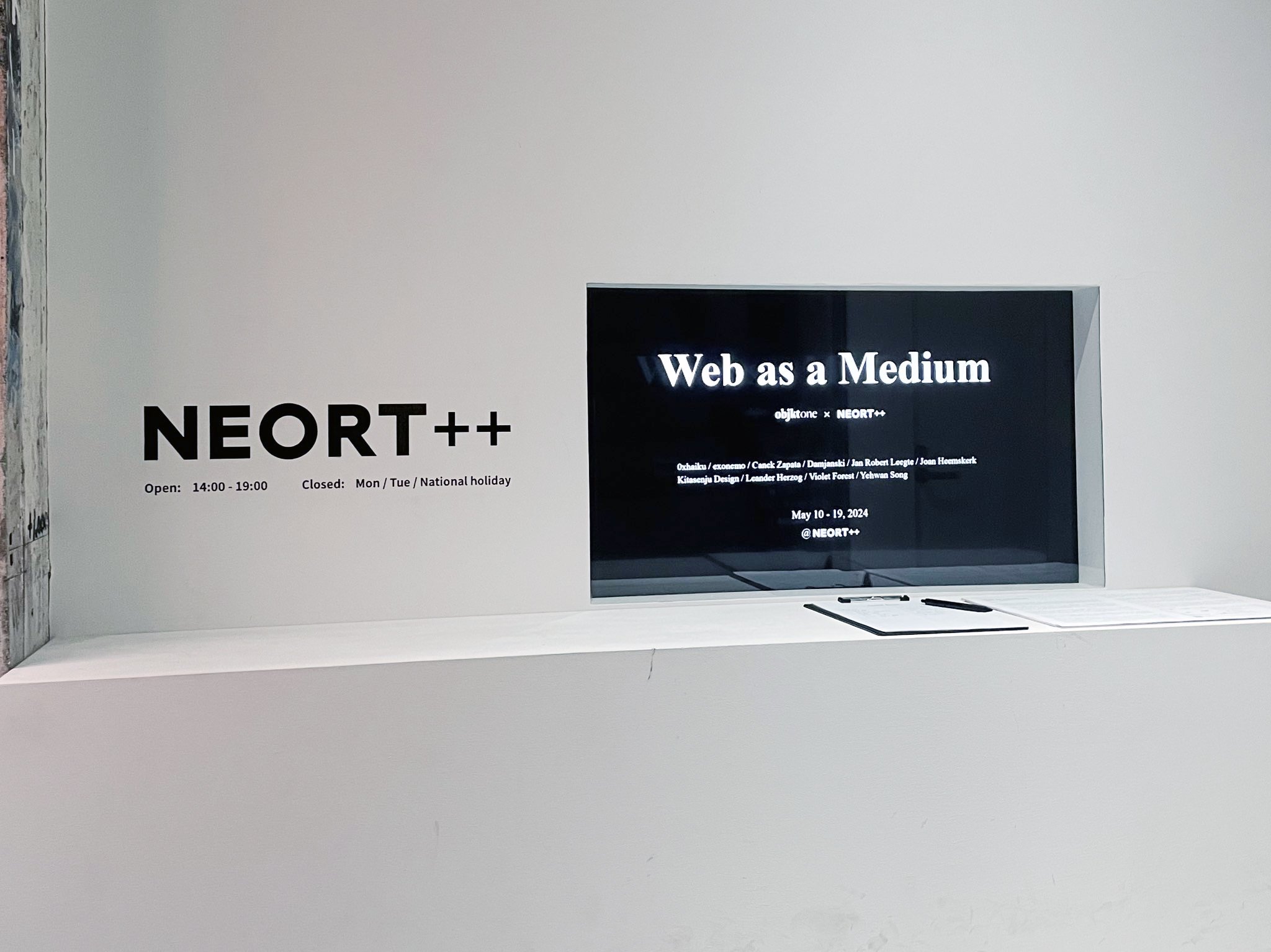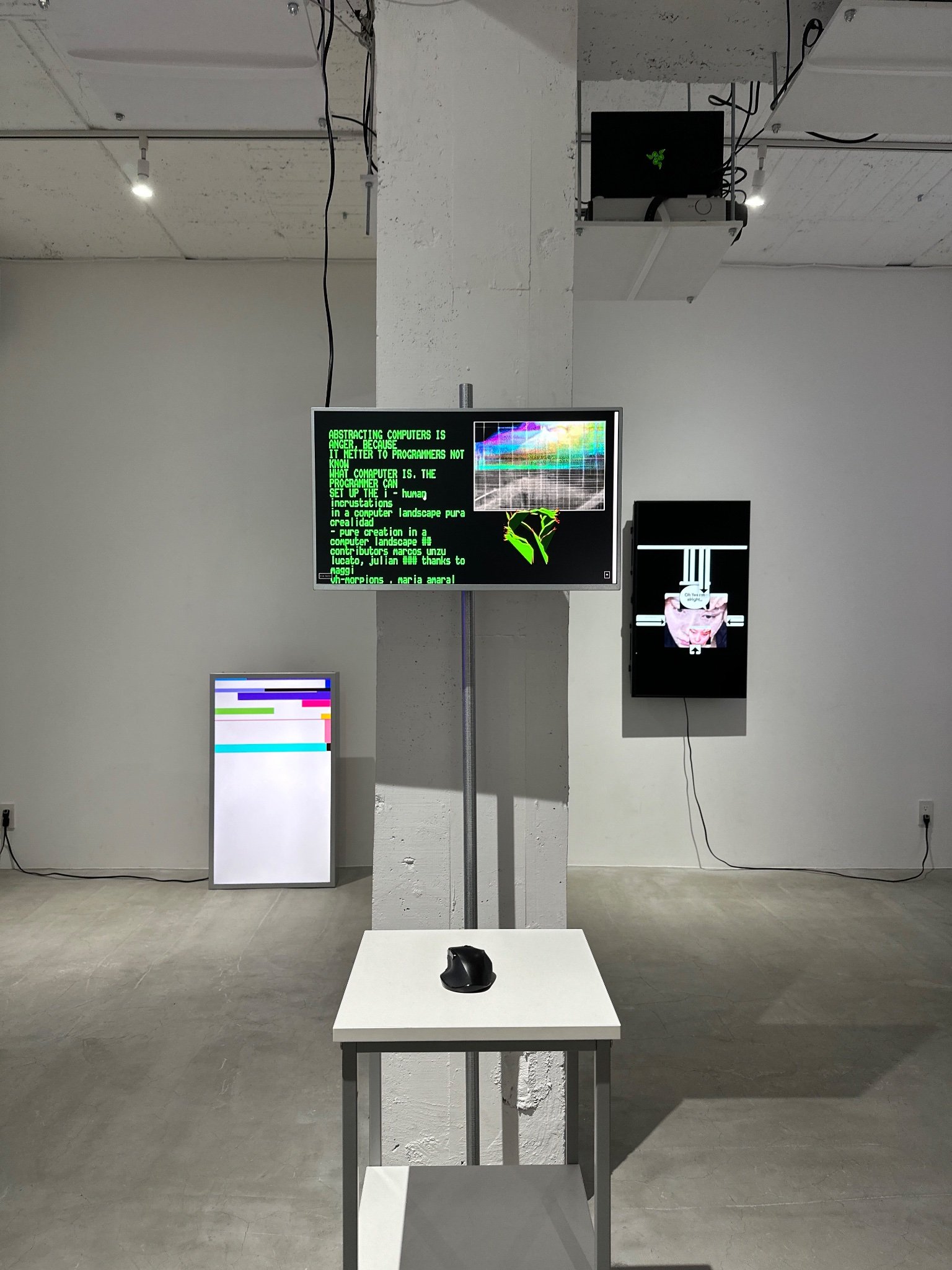Web as a Medium, Medium as the Message
The internet as the primary medium in code-based art is the theme of the exhibition on objkt.one and in real life at NEORT++ gallery in Tokyo.
Image © NEORT++
The net.art movement, considered one of the most unconventional fields of digital art, encompasses works that were founded on the internet or exclusively made for it. Studying this history and its developments, questioning and considering the ethics, aesthetics, and poetics to be explored in this info-sea of possibilities emerges "Web as Medium'', an exhibition curated by the Massage Magazine team and the NEORT++ gallery, from Tokyo.
Video © NEORT ++
The year is 2024, and we have been deeply reflecting on NFTs and Web3 in the art world for at least three years. Time flows. Following this unstoppable, ever-widening, and accelerating stream since its inception, the internet, as we have seen it develop and evolve since 1994-95, serves not only as a platform for artworks but fundamentally shapes their creation, distribution, and reception.
Web as a Medium exhibition, which physically took place in the Japanese capital from May 10th to May 19th, can be experienced online on the objkt.one platform, and stands as one of the most significant web3 shows so far.
Video © Yusuke Shono - Massage Magazine
Net.art pioneers
"My work is about the medium," says Jan Robert Leegte, a Dutch artist and one of the pioneers working with and for the Internet since the 90s. Leegte is one of the featured names in the curation, with the piece "Text Document out of Focus" from 2008, re-edited in 2004 with a JavaScript restoration of the Flash original.
Text Document out of Focus. Artist: Jan Robert Leegte. Video © Kika Nicolela.
“Beyond the frustration, there is a new freedom too — of using something that just makes us waste time, that has no function. And it’s not conventionally “beautiful,” as most artworks try to be on web3.”
"A text editor or word processor is an archetypical piece of software, a white sheet with a blinking cursor, ready to type, erase, copy, and paste. The blur, on the other hand, is an artifact from a very different media culture, that of photography and by extension, film. The out-of-focus effect is physically a product of lens-based media, and even our own biological lenses,” states the artist.
Kika Nicolela, artist and curator on objkt.com and objkt.one, says this piece by Leetge makes us, above all, aware of ourselves and our frustrations. 'And beyond the frustration, there is a new freedom too—of using something that just makes us waste time, that has no function. And it's not conventionally "beautiful," as most artworks try to be on web3,' she reflects.
“The work puts the focal depth of the observing lens on a plane far away from the screen, dissolving the always pristine crispness and sharpness of the computer interface into an absent yet fully interactive state", continues Leegte, that also raises the issue of "pixel perfect" in Photoshop as one of his questions. He wants to deconstruct this rigid concept in a way through his art, in general.
This is Not <A. Artist: Jodi. Image © Nurico
Joan Heemskerk, from JODI - an artist duo who pioneered web-based art in the mid-90s - presents “This is Not <A”, a work that physically, in the gallery, looks like a financial stock market graph projected on the wall. However, as an NFT on the objkt.one platform, it is a self-referential QR code that creates a loop exploring the concept of reference in NFTs and web-based art.
Ephemeral Art and Technological Evolution
"I guess I had many chances to exhibit together in various places. This is definitely 0xhaiku's style," says Niinomi, founder of NEORT, about the work “[Deprecated]” The Grand Canal, Venice. "He uses a marquee tag, a technology that may be discontinued soon, so it will eventually become unviewable," explains Niinomi in one of the videos from the interesting series of gallery walkthroughs available on NEORT's++ YouTube channel.
The ephemerality of artistic works based on technologies that eventually become obsolete is a constant in the universe of net art. Venice suffers from the impact of tourism and climate change, and there is an evident concern that the city will submerge and completely disappear as a consequence.
“Humans feel sorrow for what they know will be lost, even if it is digital. This shows that the Internet space is the new reality for humanity.”
[Deprecated] The Grand Canal, Venice. Artist: 0xhaiku.
The marquee tag in [Deprecated] is based on the color schemes of 18th-century European paintings of Venice, extracted and broken down into text using Web Safe Color, and will cease to function. This provokes reflection on the consequences of human behavior for the planet. "Humans feel sorrow for what they know will be lost, even if it is digital. This shows that the Internet space is the new reality for humanity," states the artist.
Nude Study and Find my Love
In the series "Nude Study" Damjanski explores the theme of Aktstudien using his "Bye Bye Camera" application as an artistic tool. Using this mobile application, he captures photographic moments by taking portions of the surroundings while erasing human presence. The work is a collaboration with Julia Seal, a movement artist, and a choreography inspired by the RGB color theme was crafted.
“It may be found immediately, or it may be hard to find. It is the same as finding love in your life.”
The intriguing “Find My Love – Infinite Computer Theorem” is inspired by the "Infinite Monkey Theorem," a thought experiment in which a monkey randomly typing on a keyboard could eventually write the works of Shakespeare. Through audience interaction, clicking the button on the page randomly generates thousands of letters until the word LOVE appears. "It may be found immediately, or it may be hard to find. It is the same as finding love in your life," states Exonemo. The piece went viral on Japanese TV, with over 300K views on their X post. Watch the video below:
Find My Love. Artist: Exonemo. Video © 日テレR&Dラボ
A Work You Can Watch Forever
Since 2006, Leander Herzog has been working using browser DOM – Document Object Model, the data representation of the objects that comprise the structure and content of a document on the web, as Niinomi explains. “I guess it falls into the category of browser art. The browser is designed as a medium for expression. At that time, generative art probably wasn't even talked about that much. I think Leander probably thought it would be interesting to have something like this, that could be generated in a browser,” he considers.
"It's a work you can watch forever," opines Niinomi, observing the visual characteristics of “Downloads”, programmed with HTML, CSS, and JS. "This unique solid minimalism, with a comfortable movement, is his trademark. The fact that this work is not a video is very important, as it is about movement, but basically, it is made up of existing DOM elements that are used on the web."
Brutalism on the Web
“Brutal Divs” is a generative art piece combining CSS3 and Brutalist web design to create a striking, algorithm-driven composition. Created by Kitasenju-san, this work emphasizes raw materials, much like the Brutalist architecture of the 1950s. In this case, the raw material is the CSS code itself, creating the notion that it can be viewed as a medium.
"In an architectural way of seeing this, it's like leaving the concrete as it is. Similarly, creating a website using only CSS and HTML elements probably aligns with this approach. It's a kind of aesthetic he adopted in his own way," states Noriaki Nakata, also from the NEORT++ team.
Post-internet art
“It has a vibrant internet aesthetic, but it also has a very indigenous feel. I’ve never seen anything like this sense of color before.”
Image © NEORT++ gallery
Considered a member of the third generation of the internet, Canek Zapata is a self-taught Mexican artist with a background in classical arts and literature. "Lands" is a retro web-inspired art piece that combines AI poetry, DALL-E visuals, code, and a unique aesthetic style. "It has a vibrant internet aesthetic, but it also has a very indigenous feel. I've never seen anything like this sense of color before," states Yusuke Shono. Indeed, the vibrant colors of vintage web aesthetics are attention-grabbing.
"It's a piece in which the poems are generated one after the other using artificial intelligence, just like the images, which are generated with the Dall-E tool," explains Yusuke Shono of Massage Magazine, co-curator of Web as a Medium. The relationship between images and poems is interesting; is it the input of the image that generates the poem, or vice versa? The question remains for the observer to ponder.
"Oh, Yes, Everything is Fine," by Yehwan Song, a Korean artist, has, as Shono explains, similar characteristics to Jan Robert Leegte, using motifs like windows and other PC desktop elements. “The piece highlights the paradox of the internet and social media, originally conceived as democratic arenas for free expression. However, they have often been perverted into tools of manipulation, veiling genuine emotions and frustrations,” states the artist.
“The piece is a reminder that the internet and the browser can and should be experienced as a medium in itself, outside of platforms, profile pages, and user-generated content like images and videos.”
Violet Forest's "OMG LOL Metaverse" welcomes you to a net surfing journey through the nostalgic internet culture that we enjoy. "She creates a story or a kind of game in which you progress through a story. I think this piece expresses the feeling that she had and allows the viewer to feel that way too," affirms Noriaki Nakata. The piece is a reminder that the internet and the browser can and should be experienced as a medium in itself, outside of platforms, profile pages, and user-generated content like images and videos," states the artist.
Considering all these artworks as an ensemble, they raise different questions, reflecting critically about the possibilities of art on the blockchain. This exhibition is an invitation to reconsider how we perceive and interact with digital art in the Web3 era. But above all, it reminds us that the internet is not only a canvas but a dynamic ecosystem where innovation and expression converge, echoing Marshall McLuhan's timeless insight into the profound impact of media on human experience.
About objkt.one
objkt.one’s curatorial approach is anchored in the long-term commitment to explore and express diverse cultural and artistic backgrounds while putting the value behind each work of art at the forefront. The drops are curated by us as well as by external curators. The onboarding process for curators consists of filling out an application form, which is currently limited to single drops/events. You can find the form here.
About NEORT++ gallery
NEORT is a Digital Art startup that aims to build a new art experience between online and offline. NEORT++ is their physical art gallery in Tokyo.





